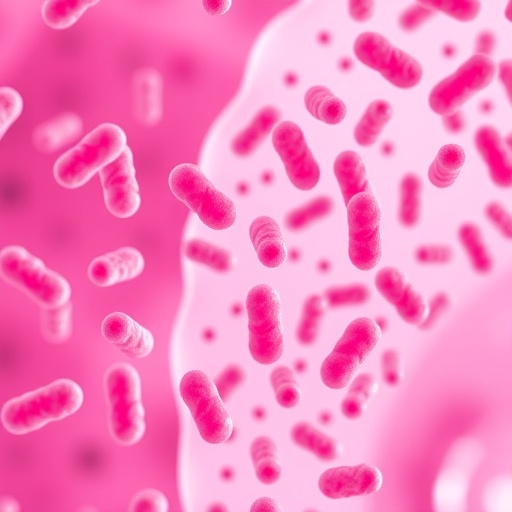In the ever-evolving battle between host immune defenses and microbial pathogens, a groundbreaking study published in Nature Microbiology unveils a critical new role for eosinophils—a class of white blood cells traditionally associated with allergic responses and parasitic infections—in the containment of persistent Salmonella infections. This research sheds light on an intricate cellular interplay within granulomas, transforming our understanding of how chronic bacterial infections are controlled and potentially opening new avenues for therapeutic intervention.
Salmonella, a genus of facultative intracellular bacteria, is notorious for its ability to evade immune clearance and establish long-term infections inside host tissues. These infections often lead to granuloma formation, which are organized immune cell aggregates designed to sequester and limit pathogen dissemination. Despite granulomas being fundamental to controlling diseases such as tuberculosis, the specific immune cell dynamics governing their persistence and efficacy against Salmonella have remained elusive. This study by Butler et al. reveals that eosinophils are not mere bystanders but active participants that enhance granuloma function to suppress persistent Salmonella infections in murine models.
Eosinophils have conventionally been studied within the context of allergy and helminth infections, where their cytotoxic granules contribute to host defense and pathology. However, their involvement in bacterial infections, particularly within granulomatous tissue structures, was poorly understood. Using cutting-edge in vivo imaging, flow cytometry, and bacterial load assays, the authors demonstrate that eosinophils are recruited to Salmonella-containing granulomas where they coordinate with macrophages and T cells to reinforce pathogen containment, thus preventing systemic spread.
One of the key mechanistic insights from this study is the ability of eosinophils to modulate the granuloma microenvironment. The researchers show that eosinophils secrete an array of immunomodulatory cytokines and chemokines that promote macrophage activation and enhance T cell recruitment, fundamentally increasing the granuloma’s antimicrobial potency. This eosinophil-driven immunological cross-talk supports a controlled environment that restricts Salmonella replication without causing excessive tissue damage—a delicate balance pivotal for chronic infection control.
Further investigation revealed that eosinophils employ reactive oxygen species (ROS) production and release cytotoxic granule proteins targeting intracellular Salmonella residing within macrophages. By assisting macrophages in elevating their bactericidal capacities, eosinophils help sustain the granuloma’s integrity. This synergy contributes to lowering pathogen burden more effectively than either cell type alone, indicating a previously underappreciated cooperative axis in innate immunity.
The implications of eosinophil involvement extend beyond bacterial clearance. The study emphasizes eosinophils’ role in maintaining granuloma architecture by regulating extracellular matrix remodeling and angiogenesis within the granulomatous tissue. These structural modulations ensure that the granuloma acts as a fortified barrier against Salmonella escape and systemic dissemination while simultaneously facilitating immune cell trafficking and nutrient supply.
Crucially, eosinophil-deficient mice displayed markedly impaired control of persistent Salmonella infection, characterized by disorganized granulomas and increased bacterial loads. This phenotype underscores eosinophils as indispensable contributors to durable host resistance. The reversal of this phenotype by adoptive transfer of eosinophils confirms the cell-intrinsic role of eosinophils in orchestrating granuloma-mediated bacterial control.
The researchers also explored the signaling pathways involved. They identified that eosinophil recruitment and activation rely heavily on IL-5 and eotaxin chemokine signaling, canonical drivers of eosinophil biology. Therapeutic modulation of these pathways could potentiate eosinophil antimicrobial functions, offering a novel strategy to reinforce host defense against persistent intracellular bacterial infections that have proven refractory to conventional antibiotic treatment.
This discovery challenges the traditional immunological paradigm that primarily credits macrophages and T cells as granuloma architects, highlighting eosinophils as vital yet overlooked players. These findings prompt reconsideration of eosinophil-targeted therapies, currently focused on limiting eosinophil activity in allergic diseases, to instead harness their beneficial roles against chronic infections.
Moreover, this study propels forward the concept that granulomas are dynamic immunological hubs where multiple innate and adaptive cells synergize, rather than being static cellular masses. Understanding these complex cellular interactions at the molecular and tissue levels promises significant advancements in infectious disease research and therapeutic development.
Study authors utilized sophisticated murine infection models that recapitulate persistent human Salmonella infections, strengthening the translational relevance of their findings. The integration of single-cell transcriptomics enabled detailed delineation of eosinophil activation states and effector functions within granulomas, unveiling previously concealed immune landscapes.
The potential clinical applications of this work could revolutionize treatment for chronic bacterial infections. Instead of solely depending on antibiotic regimens, new immunotherapeutic approaches might boost eosinophil functionality or enhance granuloma integrity. Such strategies could lead to better disease outcomes and diminished antibiotic resistance risks.
In conclusion, this study by Butler and colleagues represents a paradigm shift in our understanding of granuloma biology and infectious disease control. By illuminating the multifaceted roles of eosinophils, it opens exciting new research pathways into harnessing innate immune cells to fight persistent pathogens. As bacterial pathogens continue evolving resistance, the immune system’s hidden arsenal, exemplified by eosinophils, may provide the next frontier of infection control.
This discovery also sparks broader inquiries into eosinophils’ involvement in other granulomatous diseases beyond Salmonella, such as tuberculosis and schistosomiasis, where their presence has been noted but never fully elucidated. Future research leveraging these insights could transform therapeutic landscapes across multiple infectious and inflammatory diseases.
Ultimately, this work underscores the importance of revisiting and expanding foundational immunological dogmas to uncover unexpected defense mechanisms. Eosinophils now emerge from the shadows of immune complexity as key defenders orchestrating the containment of insidious intracellular pathogens through granuloma enhancement, promising a new era of targeted immunomodulatory treatments.
Subject of Research: Persistent Salmonella infection and the role of eosinophils in granuloma-mediated bacterial control
Article Title: Eosinophils enhance granuloma-mediated control of persistent Salmonella infection in mice
Article References:
Butler, D.S.C., Di Luccia, B., Vilches-Moure, J.G. et al. Eosinophils enhance granuloma-mediated control of persistent Salmonella infection in mice. Nat Microbiol (2025). https://doi.org/10.1038/s41564-025-02187-1
Image Credits: AI Generated
DOI: https://doi.org/10.1038/s41564-025-02187-1
Tags: chronic bacterial infection controleosinophils beyond allergies and parasiteseosinophils in bacterial infectionseosinophils role in immune defensegranuloma formation and functiongranulomatous tissue responsehost-pathogen interactionsimmune cell dynamics in granulomasNature Microbiology study insightspersistent infection managementSalmonella infection mechanismstherapeutic interventions for Salmonella





